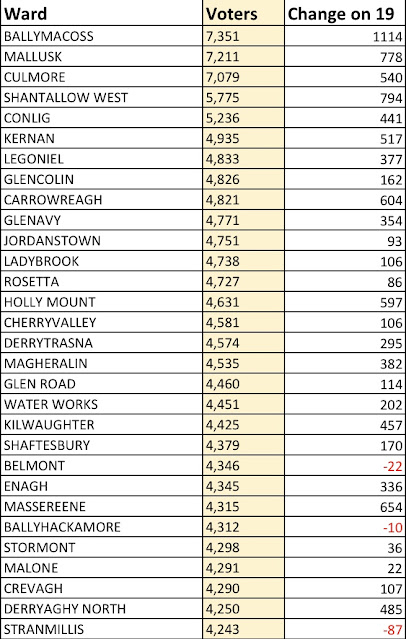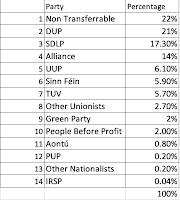NI Parliamentary electorate at the beginning of 2024.
2024 will definitely be a general election year for the UK, and will be the first election fought on the new constituency boundaries. I have had a look at how many voters are currently registered for Parliamentary elections in Northern Ireland and compared that to the register at the time of December 2019 election. Unfortunately the electoral office is still posting updates of the register based on the previous boundaries, however this is useful for a comparison to 2019 and for showing how necessary the boundary changes are. I had hoped to map the wards onto the new boundaries, but it seems some wards have also changed making an accurate comparison impossible at this stage.
There are currently 1,349,229 registered voters in Northern Ireland for a parliamentary election, this is an increase of 4.1% or 52,922 voters since December 2019.
Based on the previous constituency boundaries the largest constituency would have been Upper Bann with 86,920 voters compared to just 67,276 voters in the smallest constituency of East Antrim. The new boundaries have been drawn according to a law requiring no greater than a 5% variance in constituency size based on the 2019 electoral roll. Northern Ireland was allowed to use up to 10% variation, however the commission decided against this and instead maintained split wards. In short, the new boundaries will be more equally sized.

South Antrim and Lagan Valley (old boundaries) have increased by the greatest proportion, with Belfast South and Belfast East growing the least proportionally. I suspect this variation is largely due to these areas building new homes at a much greater rate than Belfast.
You can see those wards which have grown the most below with Ballymacoss (Lagan Valley) adding the most voters with 1,114 and Farranshane (South Antrim) growing the most proportionally adding 310 new voters but growing by a massive 27.3%! Ballymacoss actually added more voters than the total number of voters in the 29 smallest wards and has become the largest ward in Northern Ireland.

Not every Ward has added voters. You can see the biggest losers below with Windsor losing 142 voters and Harryville having the largest proportional loss, shrinking by 5.5% from 2019.
The largest ward is now Ballymacoss with 7,351 registered voters (up 1,114) and the smallest ward remains Bushmills with 519 registered voters (up 15).
It is difficult to identity any significant trends from this data alone. The one that jumps out to me is that none of the 30 largest proportional growers are in any of the 4 Belfast constituencies with only 1 (Legoniel) making into the top 30 on numbers alone. On the contrary 4 are in the bottom 30 proportionally (Knock, Stranmillis, Fortwilliam and Windsor) and 7 by numbers alone (Windsor, Stranmillis, Knock, Cregagh, Cavehill, Fortwilliam and Musgrave). Perhaps this reflects that Belfast has not been a great destination for new homes with developers, likely supported by district councils, building in the Belfast suburbs, and other cities and large/medium sized towns.
When the electoral office begins to post data using the new boundaries I will update this post to reflect that. If there are any major changes to the parliamentary battles this time around, it will likely be due to changing boundaries. The DUP are set to be more competitive in the new Belfast South and Mid Down constituency while Sinn Féin will be more confident of holding Belfast North. These new parliamentary boundaries are also set to be used at the next NI Assembly election and may lead to more dramatic changes for example a unionist seat is now likely in Belfast West with nationalists expecting to pick up a seat in Strangford.
All data was found on the electoral office website which provided monthly updates to the electoral register.








Comments
Post a Comment